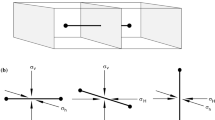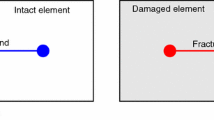Abstract
Hydraulic fracturing (fracking), using high pressures and a low viscosity fluid, allow the extraction of large quantiles of oil and gas from very low permeability shale formations. The initial production of oil and gas at depth leads to high pressures and an extensive distribution of natural fractures which reduce the pressures. With time these fractures heal, sealing the remaining oil and gas in place. High volume fracking opens the healed fractures allowing the oil and gas to flow to horizontal production wells. We model the injection process using invasion percolation. We use a 2D square lattice of bonds to model the sealed natural fractures. The bonds are assigned random strengths and the fluid, injected at a point, opens the weakest bond adjacent to the growing cluster of opened bonds. Our model exhibits burst dynamics in which the clusters extend rapidly into regions with weak bonds. We associate these bursts with the microseismic activity generated by fracking injections. A principal object of this paper is to study the role of anisotropic stress distributions. Bonds in the y-direction are assigned higher random strengths than bonds in the x-direction. We illustrate the spatial distribution of clusters and the spatial distribution of bursts (small earthquakes) for several degrees of anisotropy. The results are compared with observed distributions of microseismicity in a fracking injection. Both our bursts and the observed microseismicity satisfy Gutenberg–Richter frequency-size statistics.










Similar content being viewed by others
References
Arovas D, Bhatt RN, Shapiro B (1983) Anisotropic bond percolation in two dimensions. Phys Rev B 28(3):1433–1437, doi:10.1103/PhysRevB.28.1433.
Arthur MA, Sageman BB (1994) Marine black shales: Depositional mechanisms and environments of ancient deposits. Annual Review of Earth and Planetary Sciences 22(1):499–551, doi:10.1146/annurev.ea.22.050194.002435.
Balberg I (1987) Tunneling and nonuniversal conductivity in composite materials. Phys Rev Lett 59(12):1305–1308, doi:10.1103/PhysRevLett.59.1305.
Balberg I, Binenbaum N, Bozowski S (1983) Anisotropic percolation in carbon black-polyvinylchloride composites. Solid State Communications 47(12):989–992.
Bunde A, Havlin S (2012) Fractals and Disordered Systems, 2nd Ed. Springer London.
Celzard A, Marêché JF (2003) Non-universal conductivity critical exponents in anisotropic percolating media: a new interpretation. Physica A: Statistical Mechanics and its Applications 317(34):305–312.
Chame A, de Queiroz SLA, dos Santos RR (1984) Dimensional crossover in directed percolation. Journal of Physics A: Mathematical and General 17(12):L657.
Chaves CM, Oliveira PM, de Queiroz SLA, Riera R (1979) Remarks on the percolation problem in anisotropic systems. Progress of Theoretical Physics 62(6):1550–1555, doi:10.1143/PTP.62.1550.
Cont R, Bouchaud JP (2000) Herd behavoir and aggregate fluctuations in financial markets. Macroeconomic Dynamics 4(02):170–196.
Ebrahimi F (2010) Invasion percolation: A computational algorithm for complex phenomena. Computing in Science and Engineering 12(2):84–93, doi:10.1109/MCSE.2010.42.
Ellsworth WL (2013) Injection-induced earthquakes. Science 341(6142), doi:10.1126/science.1225942.
Family F, Vicsek T, Meakin P (1985) Are Random Fractal Clusters Isotropic? Phys Rev Lett 55(7):641–644, doi:10.1103/PhysRevLett.55.641.
Gale JFW, Reed RM, Holder J (2007) Natural fractures in the Barnett Shale and their importance for hydraulic fracture treatments. AAPG Bulletin 91(4):603–622, doi:10.1306/11010606061.
Gueguen Y, Dienes J (1989) Transport properties of rocks from statistics and percolation. Mathematical Geology 21(1):1–13.
Han KH, Lee JO, Lee SI (1991) Confirmation of the universal conductivity critical exponent in a two-dimensional anisotropic system. Phys Rev B 44(13):6791–6793, doi:10.1103/PhysRevB.44.6791.
Herrmann HJ, Sahimi M, Tzschichholz F (1993) Examples of fractals in soil mechanics. Fractals 01(04):795–805, doi:10.1142/S0218348X93000824
Hirata T, Satoh T, Ito K (1987) Fractal structure of spatial distribution of microfracturing in rock. Geophysical Journal of the Royal Astronomical Society 90(2):369–374, doi:10.1111/j.1365-246X.1987.tb00732.x.
Ikeda H (1979) Percolation in anisotropic systems: Real-space renormalization group. Progress of Theoretical Physics 61(3):842–849, doi:10.1143/PTP.61.842.
Keranen KM, Savage HM, Abers GA, Cochran ES (2013) Potentially induced earthquakes in Oklahoma, USA: Links between wastewater injection and the 2011 Mw 5.7 earthquake sequence. Geology 41(6):699–702, doi:10.1130/G34045.1.
Kim CS, Lee MH (1992) Monte Carlo renormalization group studies of anisotropic bond percolation. International Journal of Modern Physics B 06(09):1505–1515, doi:10.1142/S0217979292000700.
King G (2012) Hydraulic fracturing 101: What every fepresentative, environmentalist, fegulator, feporter, investor, university researcher, neighbor and engineer should know about estimating frac risk and improving frac performance in unconventional gas and oil wells. In: SPE Hydraulic Fracturing Technology Conference, 6–8 February, The Woodlands, Texas, USA.
King PR, Jr JS, Buldyrev SV, Dokholyan N, Lee Y, Havlin S, Stanley H (1999) Predicting oil recovery using percolation. Physica A: Statistical Mechanics and its Applications 266(14):107–114.
Klemme HD, Ulmishek GF (1991) Effective petroleum source rocks of the world; stratigraphic distribution and controlling depositional factors. AAPG Bulletin 75(12):1809–1851.
Knackstedt MA, Sahimi M, Sheppard AP (2002) Nonuniversality of invasion percolation in two-dimensional systems. Physical Review E 65(3):35,101, doi:10.1103/PhysRevE.65.035101.
Lobb CJ, Frank DJ, Tinkham M (1981) Percolative conduction in anisotropic media: A renormalization-group approach. Phys Rev B 23(5):2262–2268, doi:10.1103/PhysRevB.23.2262.
Malamud BD, Turcotte DL, Guzzetti F, Reichenbach P (2004) Landslide inventories and their statistical properties. Earth Surface Processes and Landforms 29(6):687–711, doi:10.1002/esp.1064.
Maxwell S (2011) Microseismic hydraulic fracture imaging: The path toward optimizing shale gas production. The Leading Edge 30(3):340–346, doi:10.1190/1.3567266.
Mendelson KS, Karioris FG (1980) Percolation in two-dimensional, macroscopically anisotropic systems. Journal of Physics C: Solid State Physics 13(33):6197.
Norris JQ, Turcotte DL, Rundle JB (2014) Loopless nontrapping invasion-percolation model for fracking. Phys Rev E 89(2):22,119, doi:10.1103/PhysRevE.89.022119.
Olson JE, Laubach SE, Lander RH (2009) Natural fracture characterization in tight gas sandstones: Integrating mechanics and diagenesis. AAPG Bulletin 93(11):1535–1549, doi:10.1306/08110909100.
Osborn SG, Vengosh A, Warner NR, Jackson RB (2011) Methane contamination of drinking water accompanying gas-well drilling and hydraulic fracturing. Proceedings of the National Academy of Sciences 108(20):8172–6, doi:10.1073/pnas.1100682108.
Otsuka M (1971) A simulation of earthquake occurrence part 1. A mechanical model. Zisin (Journal of the Seismological Society of Japan 2nd ser) 24(1):13–25.
Sahimi M (1994) Applications of percolation theory. Taylor & Francis, London; Bristol, PA.
Sahimi M, Robertson MC, Sammis CG (1993) Fractal distribution of earthquake hypocenters and its relation to fault patterns and percolation. Phys Rev Lett 70(14):2186–2189, doi:10.1103/PhysRevLett.70.2186.
Seager CH, Pike GE (1974) Percolation and conductivity: A computer study. II. Phys Rev B 10(4):1435–1446, doi:10.1103/PhysRevB.10.1435.
Smith LN, Lobb CJ (1979) Percolation in two-dimensional conductor-insulator networks with controllable anisotropy. Phys Rev B 20(9):3653–3658, doi:10.1103/PhysRevB.20.3653.
Sotta P, Long D (2003) The crossover from 2D to 3D percolation: Theory and numerical simulations. The European Physical Journal E 11(4):375–388, doi:10.1140/epje/i2002-10161-6.
Stauffer D, Aharony A (1994) Introduction to Percolation Theory, 2nd Ed. Taylor & Francis Group.
Sykes MF, Essam JW (1963) Some exact critical percolation probabilities for bond and site problems in two dimensions. Phys Rev Lett 10(1):3–4, doi:10.1103/PhysRevLett.10.3.
Tafti TA, Sahimi M, Aminzadeh F, Sammis CG (2013) Use of microseismicity for determining the structure of the fracture network of large-scale porous media. Phys Rev E 87(3):32,152, doi:10.1103/PhysRevE.87.032152.
Tourtelot HA (1979) Black shale; its deposition and diagenesis. Clays and Clay Minerals 27(5):313–321.
Trabucho-Alexandre J, Hay WW, de Boer PL (2012) Phanerozoic environments of black shale deposition and the Wilson Cycle. Solid Earth 3(1):29–42, doi:10.5194/se-3-29-2012.
Ulmishek GF, Klemme HD (1990) Depositional controls, distribution, and effectiveness of world’s petroleum source rocks. Tech. rep., USGS Bulletin 1931.
Warpinski NR (2013) Understanding Hydraulic Fracture Growth, Effectiveness, and Safety Through Microseismic Monitoring. In: Effective and Sustainable Hydraulic Fracturing.
Wilkinson D, Barsony M (1984) Monte Carlo study of invasion percolation clusters in two and three dimensions. Journal of Physics A: Mathematical and General 17(3):L129–L135, doi:10.1088/0305-4470/17/3/007.
Wilkinson D, Willemsen JF (1983) Invasion percolation: a new form of percolation theory. Journal of Physics A-Mathematical and General 16(14):3365–3376, doi:10.1088/0305-4470/16/14/028.
Zoback M, Kitasei S, Copithorne B (2010) Addressing the Environmental Risks from Shale Gas Development. Tech. rep., Worldwatch Institute: Natural Gas and Sustainable Energy Initiative.
Acknowledgments
The research of JQN and JBR has been supported by a grant from the US Department of Energy to the University of California, Davis #DE-FG02-04ER15568.
Author information
Authors and Affiliations
Corresponding author
Rights and permissions
About this article
Cite this article
Norris, J.Q., Turcotte, D.L. & Rundle, J.B. Anisotropy in Fracking: A Percolation Model for Observed Microseismicity. Pure Appl. Geophys. 172, 7–21 (2015). https://doi.org/10.1007/s00024-014-0921-9
Received:
Revised:
Accepted:
Published:
Issue Date:
DOI: https://doi.org/10.1007/s00024-014-0921-9




